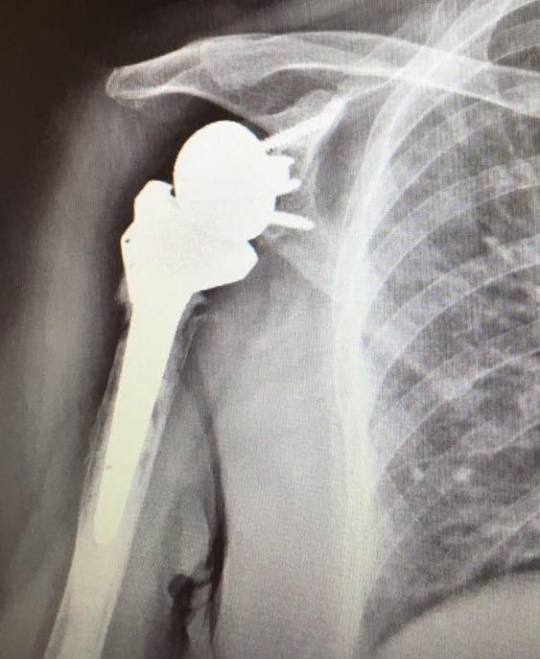| |||||||||||
|
lunes, 27 de febrero de 2017
APACHE II en cuidado crítico obstétrico / APACHE II in obstetric critical care
Primera artroplastía de anatomía reversa de hombro en México

Primera artroplastía de anatomía reversa de hombro en México »
Hoy hace 10 años se hizo la primera artroplastía de anatomía reversa de hombro en México. Este evento marco un antes y después en la cirugía de hombro en nuestro país. Diez años después, la paciente está con función del hombro completa y muy satisfecha con el resultado a sus 83 años. Ese equipo quirúrgico liderado por mi maestro y amigo Fernando Valero y 2 de los mejores cirujanos que he conocido Iván Encalada y Mario Crespo Pacheco fue increíble. Un honor haber sido parte de ese equipo.
viernes, 24 de febrero de 2017
Lesiones ligamentosas en el deportista
Fuente Este artículo es originalmente publicado en:
http://footankleco.com/lesiones-ligamenstosas-en-el-deportista/
Lesiones ligamentosas en el deportista https://t.co/04HHPD6Kv7— Enrique Martínez (@MgJenrique)22 de febrero de 2017
Satisfacción, funcionalidad y reparación integra posterior a una reparación artroscopica versus un abordaje mini-open del manguito rotador
Satisfaction, function and repair integrity after arthroscopic versus mini-open rotator cuff repair
Fuente
Este artículo es originalmente publicado en:
Este artículo es originalmente publicado en:
De:
Bone Joint J. 2017 Feb;99-B(2):245-249. doi: 10.1302/0301-620X.99B2.BJJ-2016-0055.R1.
Todos los derechos reservados para:
©2017 The British Editorial Society of Bone & Joint Surgery.
Abstract
AIMS:
Advances in arthroscopic techniques for rotator cuff repair have made the mini-open approach less popular. However, the mini-open approach remains an important technique for repair for many surgeons. The aims of this study were to compare the integrity of the repair, the function of the shoulder and satisfaction post-operatively using these two techniques in patients aged > 50 years.
CONCLUSION:
The integrity of the repair and function of the shoulder were better after a mini-open repair than after arthroscopic repair of a rotator cuff tear in these patients. The functional difference did not translate into a difference in satisfaction. Mini-open rotator cuff repair remains a useful technique despite advances in arthroscopy. Cite this article: Bone Joint J 2017;99-B:245-9.
©2017 The British Editorial Society of Bone & Joint Surgery.
KEYWORDS:
Arthroscopy; Mini-open; Rotator cuff integrity; Rotator cuff repair; Shoulder function
Resumen
OBJETIVOS:
Los avances en las técnicas artroscópicas para la reparación del manguito rotador han hecho que el enfoque mini-abierto sea menos popular. Sin embargo, el enfoque mini-abierto sigue siendo una técnica importante para la reparación de muchos cirujanos. Los objetivos de este estudio fueron comparar la integridad de la reparación, la función del hombro y la satisfacción postoperatoria con estas dos técnicas en pacientes mayores de 50 años.
Los avances en las técnicas artroscópicas para la reparación del manguito rotador han hecho que el enfoque mini-abierto sea menos popular. Sin embargo, el enfoque mini-abierto sigue siendo una técnica importante para la reparación de muchos cirujanos. Los objetivos de este estudio fueron comparar la integridad de la reparación, la función del hombro y la satisfacción postoperatoria con estas dos técnicas en pacientes mayores de 50 años.
CONCLUSIÓN:
La integridad de la reparación y la función del hombro fueron mejores después de una reparación mini-abierta que después de la reparación artroscópica de un desgarro del manguito rotador en estos pacientes. La diferencia funcional no se tradujo en una diferencia en la satisfacción. La reparación del manguito de los rotadores con mini-apertura sigue siendo una técnica útil a pesar de los avances en la artroscopia. Citar este artículo: Bone Joint J 2017; 99-B: 245-9.
© 2017 Sociedad Editorial Británica de Cirugía de Huesos y Articulaciones.
PALABRAS CLAVE:
Artroscopia; Mini-abierto; Integridad del manguito rotador; Reparación del manguito rotador; Función del hombro
PMID: 28148668 DOI:
[PubMed – indexed for MEDLINE]
Suscribirse a:
Entradas (Atom)




